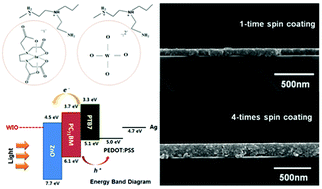The optoelectronic properties of tungsten-doped indium oxide thin films prepared by polymer-assisted solution processing for use in organic solar cells
Abstract
Tungsten-doped indium oxide (WIO) transparent conducting thin films, to be used in inverted organic solar cells (IOSCs), were prepared by a polymer-assisted solution (PAS) process. Tungsten has high Lewis acid strength and it is, therefore, a promising candidate dopant for formulating high-mobility transparent conducting oxides with high transmittance over a wide range of regions from visible to near-infrared. WIO–PAS was formulated by coordinating W- and In-anionic complexes with a water-soluble polymer, and subsequently spin-coated on glass substrates and heat-treated at elevated temperatures. The final WIO–PAS coating solution was prepared by adding W-PAS and In-PAS with W concentrations in solution ranging from 1 at% to 5 at%. The optimum W concentration resulting in the lowest resistivity of 7.38 × 10−4 Ω cm was 3 at%. The optimum PAS-processed WIO (PAS–WIO) film, having a thickness of 230 nm, had a sheet resistance of 38 Ω sq−1 and an optical transmittance greater than 85%. The potential of the optimum PAS–WIO films in IOSCs was also assessed. The IOSCs prepared with PAS–WIO films had a power conversion efficiency (PCE) of 5.6%, which is comparable to the PCE values of IOSCs with commercial tin-doped indium oxide (ITO) films. This suggests that the PAS–WIO films are a cost-effective alternative to the vacuum-based ITO films used for the fabrication of optoelectronic devices.



 Please wait while we load your content...
Please wait while we load your content...